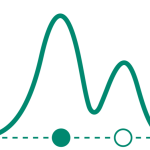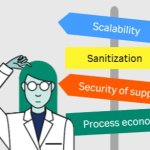In this interview, Jakob Liderfelt, Product Manager at Cytiva, discusses main challenges faced during chromatography process development for mAbs and mAb variants such as fragments and bispecific antibodies. Then, he shares his top tips for addressing challenges associated with mAb aggregates removal and separation of homo and heterodimers.
New further support from Cytiva?
Click here to request a free consultation, resin sample, or a quote for your antibody purification.
Transcript
Jeanne Linke Northrop: Hello, I’m Jeanne Linke Northrop, Managing Editor with BioPharm International. I’m joined today by Jakob Liderfelt, a Global Product Manager for monoclonal antibody polishing with Cytiva. Jakob, thank you so much for your time today.
Jakob Liderfelt: It’s very nice to be here. Thank you for giving me this opportunity.
Jeanne Linke Northrop: Absolutely. I’m looking forward into diving into a discussion about antibody therapies. We’ve seen this specific drug class continue to reshape medicine, right? It’s so amazing what we’ve learned about these molecules, their potential, the different ways to leverage these proteins. I’m really looking forward to having a discussion with you about downstream processing and some of the challenges, in terms of producing these therapies.
First and foremost, because no drug development project ever presents without challenges, unfortunately, as we’re all aware of, what types of challenges are you seeing associated with antibody therapies during downstream processing?
Jakob Liderfelt: Today I would say the biggest challenge is the diversification. If we look back a couple of years, we saw that the main antibody group was monoclonal antibodies. But today, it’s a lot more diverse. We see more fragments, such as Fabs, scFv fusion proteins, domain antibodies, single chain fragments variable. And we also see bi- and multi-specific antibodies where you have variable site that can target two or more antigens at the same time. So this diversification, where it’s a difference in size, shape, isoelectric point. etc., presents a challenge. And that, I would say, is the biggest challenge today.
If we look at how the mAbs were purified, it was mostly based on platforms. With the same process or with very small adjustment, you could purify multiple different targets or multiple different targets of interest. But today, these platforms are harder to use because of diversity between different targets.
So it’s the same impurities, but it’s difficult not being able to go fast without running extensive process development. So it takes a long time to develop the process today because of this diversification.
Jeanne Linke Northrop: So what are your suggestions in regards to addressing the challenges?
Jakob Liderfelt: I would say it’s built on understanding the different resins and having a deeper understanding of the target of interest, and the impurities. It’s various different base matrixes. They have different sizes, they are built from different types of materials. We have a large array of different ligands. So to understand these, what are the benefits? What are their kind of weak spots? So look at different capacities, flow rates, efficiency, etc. There’s always trade-offs when it comes to resins and performance. One resin cannot do it all. So you have to understand these different types of resins that are on the market. And together with that, you must have knowledge about the target molecule and how it behaves in what conditions. Is it stable? And what is the challenging impurity that you’re trying to solve? These things will help you build a strategy towards different impurities. If you end up in a certain challenge, you know what resin to choose from, when it appears.
Jeanne Linke Northrop: You’ve been highlighting quite a few different challenges, and there’s so much during these process development stages. Maybe you could pick two specific challenges, and based on your actual experience, provide some tips for overcoming these challenges?
Jakob Liderfelt: I would choose aggregates. That’s probably the biggest challenge that we see. That’s where we end up in conversations with clients about how to remove them, but also mispairs or separation of homo/hetero-dimers or bispecific antibodies. So we’ll start with aggregates.
So let’s assume that we have a starting platform, or a process, based on protein A, ion exchange step. So, a cation exchange step and an anion exchange step. If we look at this process, the typical step that removes aggregates is the cation exchange step. So let’s leave that for now and look at the anion exchange step. If we change this to a multimodal anion exchange step, instead, you have a much better probability of removing aggregates. The hydrophobicity that the multimodal ligands introduces are a lot more efficient at removing aggregates.
We would recommend looking at Capto™ adhere resin, if you can operate in flowthrough mode, or Capto™ adhere ImpRes resin, if you want to work in bind-elute mode. That typically takes care of the aggregates. But if you still have challenging aggregates, you can look at the cation exchange step and change that to a hydrophobic interaction step. That would be Capto Phenyl (high sub) resin, for instance. That has shown very good success in removing aggregates, but it may be too hydrophobic, so then we can go for a Capto Butyl resin instead. So just a few selected resins can actually be screened in order to quickly address an aggregate challenge.
The second challenge is separating homo and heterodimers in a bispecific antibody. For example, if we have an antibody or a bispecific antibody based on one kappa light chain and one lambda light chain, and we can have the same heavy chain in this case, they give two distinct impurities: the kappa heterodimer and the lambda heterodimer. If we work with protein A, that binds to the Fc part and also, often, to the variable domain of the heavy chain, you are unable to distinguish between these species. So, the kappa lambda heterodimer and the kappa lambda homodimers. Protein A would bind them all and they would be eluted in the same pool. But working with protein L, that only binds kappa subclass one, three and four, for instance, MabSelect™ VL, you could get a really high purity sample during the capture step. Since the lambda heterodimer would not bind to the MabSelect™ VL, it would be collected in the flowthrough. But both the kappa homodimer and the lambda kappa heterodimer would bind. But since the kappa homodimer has two kappa light chains, it would be harder to bind.
With the pH gradient you would first elute the target of interest, the kappa lambda heterodimer, and thereafter, the kappa homodimer. You can separate the two different impurities in the capture system. But this may not always be sufficient to remove all of the mispairs. So you don’t have to work in the polishing step. So here you have to work in the polishing step.
Again, if we have the cation exchange and the anion exchange steps as the platform, we recommend looking at the multimodal on the cation exchange step. So, multimodal cation exchange, such as Captop MMC ImpRes or Captop MMC. We recommend the Capto MMC ImpRes because of the smaller beads. This has been demonstrated several times…that it’s good at removing mispairs.
Sometimes hydrophobic interaction works well. We would recommend to keep using the ImpRes beads because they are small and give very high efficiency. It’s also available as multimodal, but typically has lower resolution. The same goes with anion exchange. Use a multimodal anion exchange step like Capto adhere ImpRes to get good clearance of mispairs.
So again, you can choose just a few selected resins that really address the challenge, instead of screening a large array of resins and hoping to find one that will work.
Jeanne Linke Northrop: Do you have any further recommendations that you’d like to provide to our audience about antibody therapies, process development? More specifically, what can be done to streamline downstream processing?
Jakob Liderfelt: I would really recommend utilizing high throughput tools, or different tools to increase the learnings during process development. High throughput process development means that you run multiple experiments in parallel so you can screen a large array of different conditions in a quick period of time. So for instance, PreDictor™ plates, plates, a 96-well format, where you can screen 96 different conditions in the same experiment. There are also small, miniature columns that can be utilized in the same way. So that will speed up the experiments that you’re running, but also utilize the design of experiment, where you want to get the most out of each individual experiment. Each experiment will not give you that much information, but the combination will give more learnings than running one experiment at a time.
And to really increase your learning, you can also work with mechanistic modeling. In a mathematical way, this describes how different components or different substances behave inside the column. This provides a deep understanding of how the separation process take place. We have the GoSilico™ Chromatography Modeling Software and f(x) columns that can be combined for fast mechanistic modeling.
So, it’s really about speeding up the learning process. If you learn quicker, your process development will be quicker. That would be my final recommendation of how to move forward in the future.





